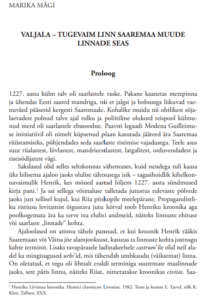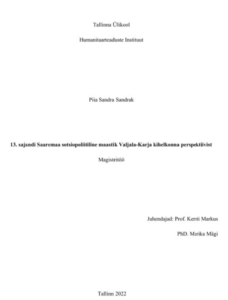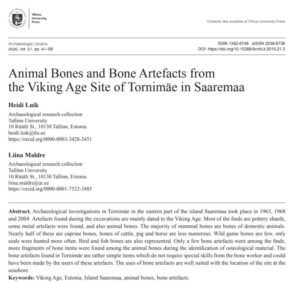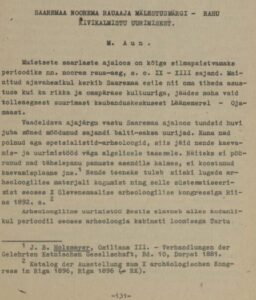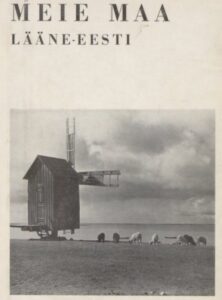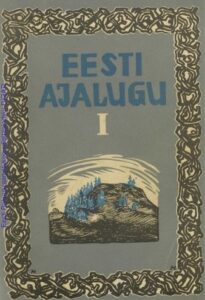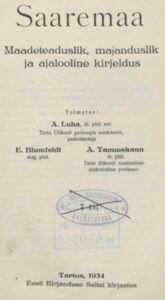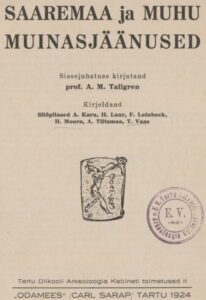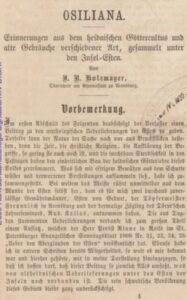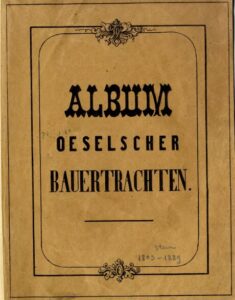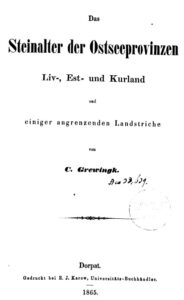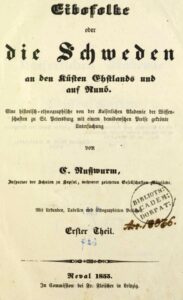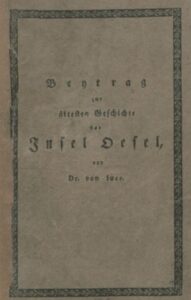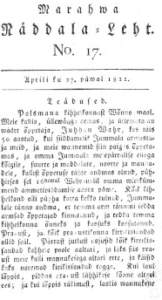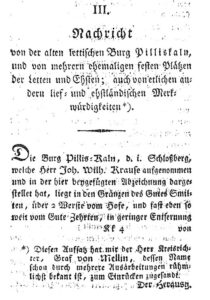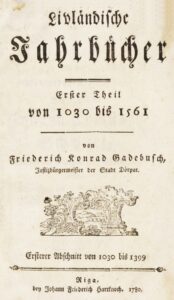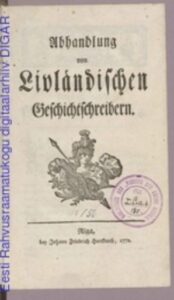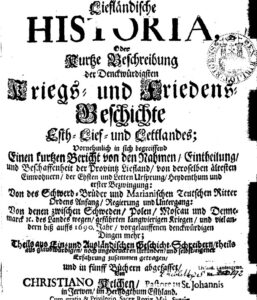Mägi, M. (2025). Valjala – tugevaim linn Saaremaa muude linnade seas. Pesti, O. (Toim.). Saaremaa muuseum kaheaastaraamat 2023-2024. (3−33). Kuressaare: SA Saaremaa Muuseum väljaanne.
Read the article (EST): here.
Mägi, M. (2024). Report of archaeological excavations in Valjala hillfort. Excavation J. 2023. (EST: Aruanne Valjala maalinna arheoloogilistest kaevamistest. Kaevand J. 2023). SA Osiliana/Tallinn University.
Read the report: here.
Archaeological and ground penetrating radar investigations around three Saaremaa hill-forts – Valjala, Pöide and Kaarma. Arheoloogilised välitööd Eestis = Archeological fieldwork in Estonia, 2022, 73−90.
- 2024
- 2023
- 2022
- 2021
- 2020
- 2019
- 2018
- 2017
- 2016
- 2015
- 2014
- 2013
- 2012
- 2011
- 2010
- 2009
- 2008
- 2007
- 2006
- 2005
- 2004
- 2003
- 2002
- 2001
- 2000
- 1999
- 1998
- 1997
- 1996
- 1995
- 1994
- 1993
- 1990
- 1984
- 1982
- 1979
- 1977
- 1974
- 1966
- 1964
- 1962
- 1961
- 1959
- 1958
- 1956
- 1948
- 1936
- 1934
- 1927
- 1924
- 1899
- 1898
- 1891
- 1880
- 1872
- 1870
- 1868
- 1855
- 1846
- 1842
- 1827
- 1821
- 1794
- 1780
- 1772
- 1740
Sandrak, P. S. (2022). The socio-political landscape of 13th century Saaremaa from the perspective of Valjala-Karja parish (EST: 13. sajandi Saaremaa sotsiopoliitiline maastik Valjala-Karja kihelkonna perspektiivist). Master thesis (sup.) Kersti Markus; Marika Mägi. Tallinn University.
Read the ENG conclusion (70-72): here.
Luik, H.; Maldre, L. (2020). Animal Bones and Bone Artefacts from the Viking Age Site of Tornimäe in Saaremaa. Archaeologia Lituana, 21, 41−58. DOI: 10.15388/ArchLit.2019.21.3.
Read the article: here.
Kadakas, Villu; Kreem, Juhan (2019). Der Baukompex von Peude auf Ösel. Eine frühe Ordensburg mit einem Nachleben? Juhan Kreem. Das Leben im Ordenshaus (99−116). VDG. (Quellen und Studien zur Geschichte des Deutschen Ordens; 81).
Read the article (GER): here.
Mägi, M. (2018). Pre-Christian maritime societies in the Eastern Baltic. Revue d’Histoire Nordique = Nordic Historical Review, 26, 27−48.
Read the article: here.
Markus, K. (2017). From Rus’ Trade to Crusade: St Olaf’s Churches in the Eastern Baltic Sea Region. Acta Historica Tallinnensia, 23, 3−25. DOI: 10.3176/hist.2017.1.03.
Read the article: here.
Mägi, M.; Allmäe, R.; Riiel, R.; Karro, K.; Limbo-Simovart, J. (2015). Archaeological excavations at Bronze Age grave and 6th – 10th century cult site at Saunamäe, Tõnija-Põlluküla, southern Saaremaa. Arheoloogilised välitööd Eestis = Archeological fieldwork in Estonia, 2014, 79−96.
Read the article: here.
Jets, I. (2012). Scandinavian Late Viking Age Art Styles as a Part of the Visual Display of Warriors in 11th Century Estonia. Estonian Journal of Archaeology, 16 (2), 118−139. DOI: 10.3176/arch.2012.2.02.
Read the article: here.
Mägi, M. (2010). Trade, war and the diversity of rituals at late prehistoric harbour sites on Saaremaa. Archaeologia BALTICA, 14, 168−182.
Read the article: here.
Mägi, M. (2009). Harbour sites in ritual landscape – the example of Viltina in southern Saaremaa. Estonian Journal of Archaeology, 13: 2, 110−131.
Read the article: here.
Mägi, M. (2005). On the mutual relationship between late prehistoric Saaremaa and the Livs. In: Mäntylä, S. (Ed.). Rituals and relations. Studies on the Society and Material Culture of the Baltic Finns (187−206). Helsinki: Academia Scientiarum Fennica. (Suomalaisen Tiedeakatemian toimituksia. Humaniora; 336).
Read the article: here.
Livonian Chronicle of Henry: Heinrici chronicon Livoniae. (EST: Henriku Liivimaa kroonika). (1982). Tarvel, Enn (edit.); Kleis, R. (transl.). Publisher: Tallinn, Eesti Raamat.
Read the chronicle (in Latin and Estonian): here.
Saaremaa and its inhabitants are mentioned in the following chapters:
VII (1-2);
VIII (3);
X (13);
XIV (12);
XV (3);
XVIII (8);
XIX (1-3);
XIX (5-6);
XIX (9,11);
XX (7-8);
XXI (5,7);
XXII (1,8-9);
XXIII (9-10);
XXIV (3);
XXIV (5,7);
XXV (2);
XXVI (2-5,8,11);
XXVII (3);
XXVIII (3,7);
XXIX (1,4);
XXX (1-5).
Kustin, A. (1966). Stone circle grave in Kurevere at Saaremaa. (EST: Kiviringkalme Kureveres Saaremaal.) Moora, H.; Selirand, J. (toim). Pronksiajast varase feodalismini. Uurimusi Baltimaade ja naaberalade ahreoloogiast. Tallinn: Eesti Raamat, lk 87-95.
Text in EST, but conlusion in RUS p. 94, GER p. 94-95: here.
Aun, M. (1961). Research on the Rahu stone burial ground, a monument to the early Iron Age on Saaremaa. (EST: Saaremaa noorema rauaaja mälestusmärgi – Rahu kivikalmistu uurimisest). Ajalooalaseid uurimistöid. ÜTÜ Ajalooringi kogumik (131-163). Tartu: Tartu Ülikooli Kirjastus.
Read the article (EST): here.
Kangro, B., Uibopuu, V (edit). (1956). Our Land. Part 2, Western Estonia: Estonia in Words and Pictures (EST: Meie maa. 2. osa, Lääne-Eesti: Eesti sõnas ja pildis). Lund: Eesti Kirjanike Kooperatiiv.
Read (EST): here.
Metsar, L. (1950). Report on the excavation of a stone grave located on the north corner of the limestone quarry of Kilgiaugu in Käku village at Kaarma parish in 1.-29. VII. 1949. (EST: Aruanne Kaarma valla Käku küla Kilgiaugu paemurru põhjakaldal asuva kivikalme kaevamisest 1.-29.VII. 1949. a.) Tartus, 1. veebruaril 1950.
Read the report (EST): here.
Metsar, L. (1948). Report on the excavation of a stone grave located on the north corner of the limestone quarry of Kilgiaugu in Käku village at Kaarma parish. (EST: Aruanne Kaarma valla Käku küla Kilgiaugu paemurru põhjakaldal asuva kivikalme kaevamisest.) 13. VIII-27. VIII 1948.a.
Read the report (EST): here.
Moora, H.; Laid, E.; Mägiste, J.; Kruus, H. (1935). Estonian history. I. Prehistory and Ancient War of Freedom (EST: Eesti ajalugu. I, Esiajalugu ja muistne vabadusvõitlus). Tartu: Eesti Kirjanduse Selts.
Read (EST): here.
Editors: Artur Luha, August Tammekann, Evald Blumfeldt. (1934). Saaremaa: geographical, economic, and historical description. (EST: Saaremaa: maadeteaduslik, majanduslik ja ajalooline kirjeldus). Tartu: Eesti Kirjanduse Selts. Kodu-uurimise toimkond.
Read (in EST): here.
Eisen, M. J. (1927). Tõll and his kinship. (EST: Tõll ja ta sugu.) Tartu: Eesti Kirjanduse Selts.
Electronical reproduction: Tallinn: Academic Library of TLU, 2016.
Read the book (EST): here.
Vaas, T., Moora, A., Moora, H., Laur, H., Tiitsmaa, A., Linnus, F. (1924). Archaeological remains of Saaremaa and Muhu. (EST: Saaremaa ja Muhu muinasjäänused). Tartu: Odamees – Carl Sarap.
Read (EST): here.
Körber, M. (1899). Oesel einst und jetzt. Zweiter Band, Die Kirchspiele Mustel, Kielkond, Anseküll, Jamma, Wolde und Pyha. Arensburg: Arensburger Wochenblatt.
Read (GER): here.
Publication. (1898). Publikationen des Vereins zur Kunde Ösels. Riga/Riia.
Electronical reproduction. Tallinn: Estonian National Library, 2017.
Read the publication (GER): here.
Holzmayer, J. B. (1872). Erinnerungen aus dem heidnischen Göttercultus und alte Gebräuche verschiedener Art, gesammelt unter den Insel-Esten. Lithographer: Carl Anton Schulz. Arensburg/Kuressaare.
Electronical reproduction: Estonian National Library.
Read the publication (GER): here.
Stern, F. S. (1870). Album oeselscher Bauertrachten. Kuressaare.
Have a look: here.
Holzmayer, J. B. (1868). Osiliana. I., Das Kriegswesen der alten Oeseler. Arensburg/Kuressaare.
Electronical reproduction: Estonian National Library, 2021.
Read the publication (GER) here.
von Grewink, C. A. C. (1865). Das Steinalter der Ostseeprovinzen Liv-, Est- und Kurland und einiger angrenzenden Landstriche. Dorpat: E. J. Karow.
Read (GER): here.
Russwurm, C. F. W. (1855). Eibofolke oder die Schweden an den Küsten Ehstlands und auf Runö I–II. Reval.
Read (GER): here.
Kruse, K. (1846). Mehrere für die ältere Geschichte Dänemarks und der Ostseeprovinzen wichtige, bisher bestrittene Urkunden d. X.-XIV. Jahrhunderts. Leipzig: Brandes.
Electronical reproduction. Tartu: University of Tartu Library, 2015.
Read it (GER): here.
Kruse, F. (1842). Necrolivonica oder Alterthümer Liv-, Esth- und Curlands bis zur Einführung der Christlichen Religion in den Kaiserlich Russischen Ostsee-Gouvernements, zusammengestellt und historisch erläutert in einem Unterthänigsten Generalberichte über seine auf Allerhöchsten Befehl im Jahre 1839 ausgeführte archaeologische Untersuchungsreise nebst mehreren wissenschaftlichen Excursen und vielen Lithographien von Alterthümern, Plänen und Charten. Dorpat: F. Kruse, H. Laakmann [etc]; Leipzig: L. Voss.
Electronical reproduction: Google Books.
Read it (GER): here.
von Luce, J. W. L. (1827). Wahrheit und Muthmassung: Beytrag zur ältesten Geschichte der Insel Oesel. Pernau: G. Marquardt.
Read (GER): here.
Marahwa Näddala-Leht, Number 17, 27 April 1821. Contains three texts in Estonian about Saaremaa, Muhumaa and Ruhnu island:
P. 132-135 text: “Kurre-Saar, ehk Sarema”,
p. 135-136 text: “Muhho-ma”,
p. 136 text: “Runo-saar”.
Read: here.
In DIGAR gothic text has been converted into easily readable text that is presented on the left hand of the page.
Mellin, L. A. (1794). Nachricht von der alten lettischen Burg Pilliskaln, und von mehrern ehemaligen festen Plätzen der Letten und Ehsten; auch von etlichen andern lief- und ehstländischen Merkwürdigkeiten. – Hupel, A. W. (edit). Neue Nordische Miscellaneen, 9-10, 519-545. Riga: Johann Friedrich Hartknoch.
Read (GER): here.
Gadebusch, F. K. (1780). Livländische Jahrbücher. Erster Theil von 1030 bis 1561. Ersterer Abschnitt von 1030 bis 1399. Riga: Johann Friedrich Hartknoch.
Read (GER): here.
Gadebusch, F. K. (1772). Abhandlung von Livländischen Geschichsshreibern. Riga: J. F. Hartknoch.
Read (GER): here.
Gruber, J. D. (1740). Origines Livoniae sacrae et civilis, seu chronicon Livonicum vetus, continens res gestas trium primorum episcoporum: quibus devictae a Saxonibus, et ad sacra christianorum traductae Livoniae absolvitur historia: a pio quodam sacerdote, qui ipse tantis rebus interfuit, conscripta, et ad annum Christi nati MDCCXXVI. deducta. E Codice MS. recensuit, scriptorum cum aetate, tum locis vicinorum testimoniis illustravit, silvamque documentorum et triplicem indicem adjecit Joan. Daniel Gruber. Frankfurt, Leipzig.
Read (LAT): here.
Kelch, C. (1695). Liefländische Historia. Reval.
Read (GER): here.

